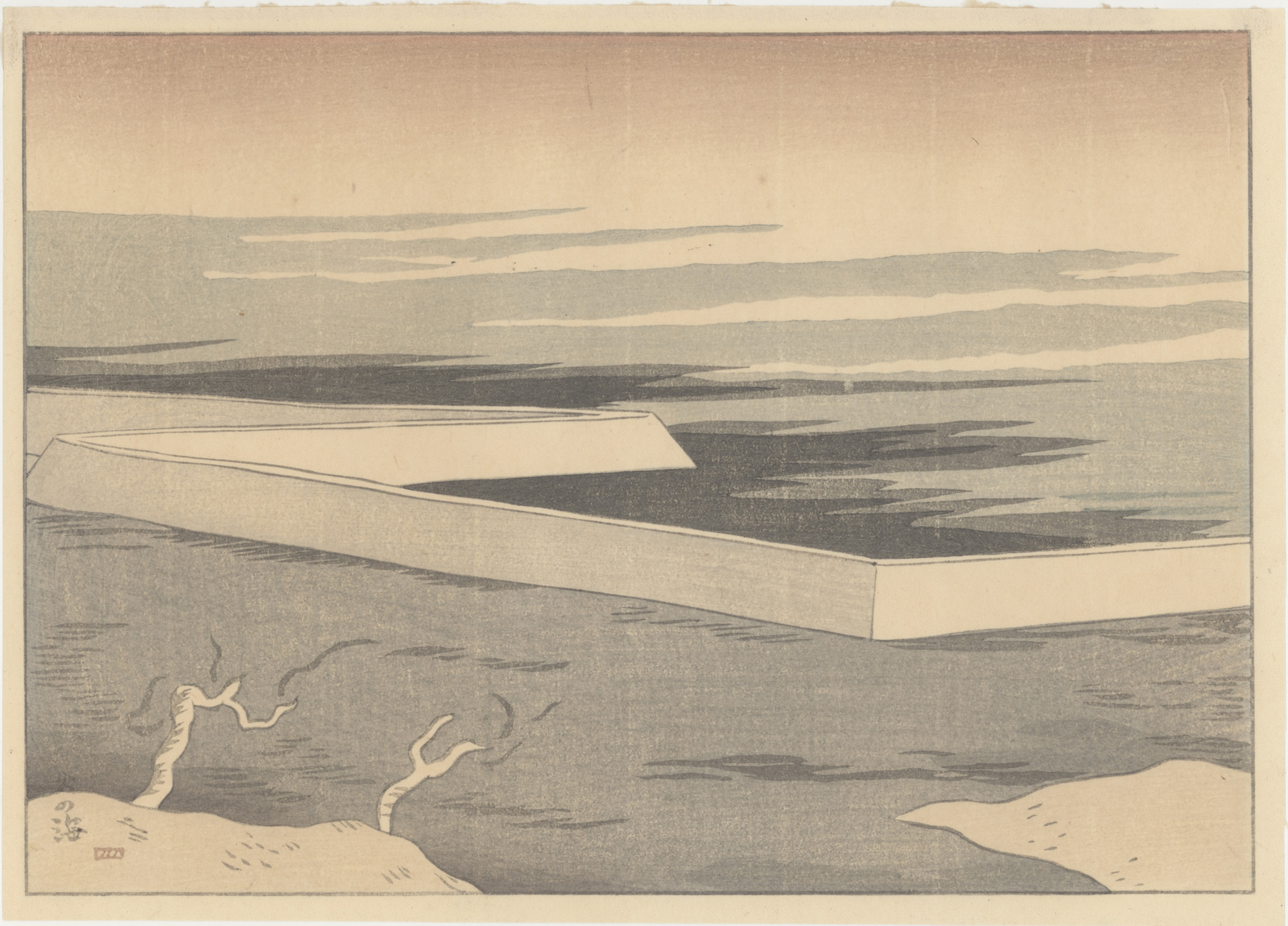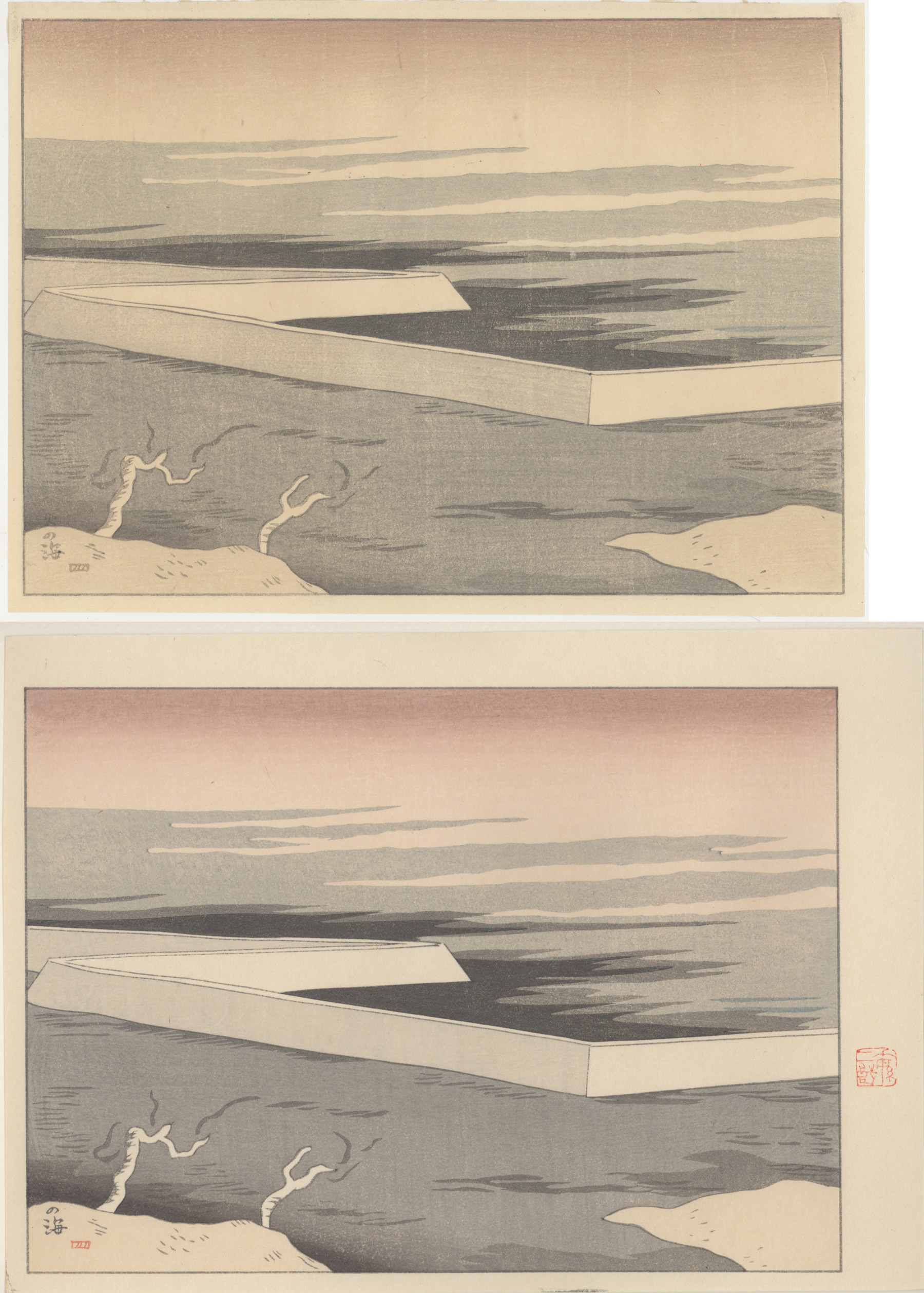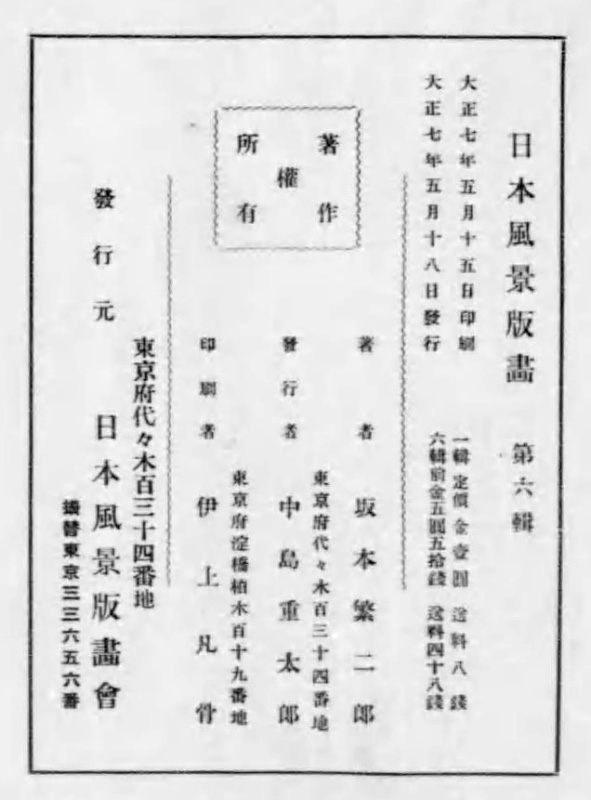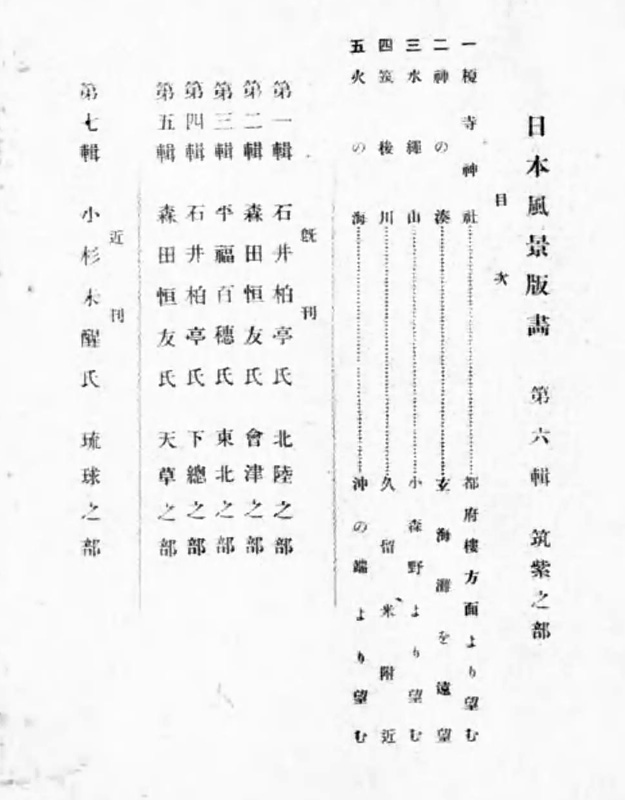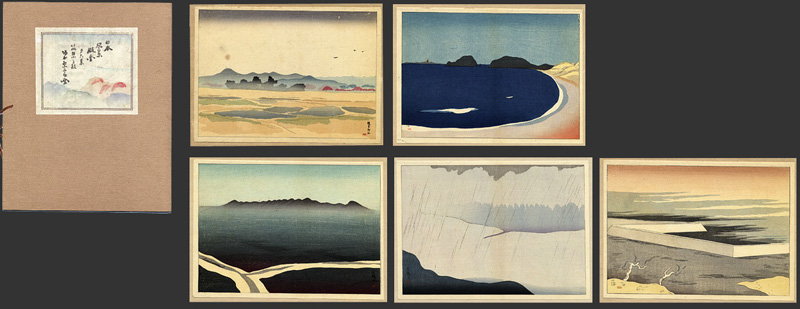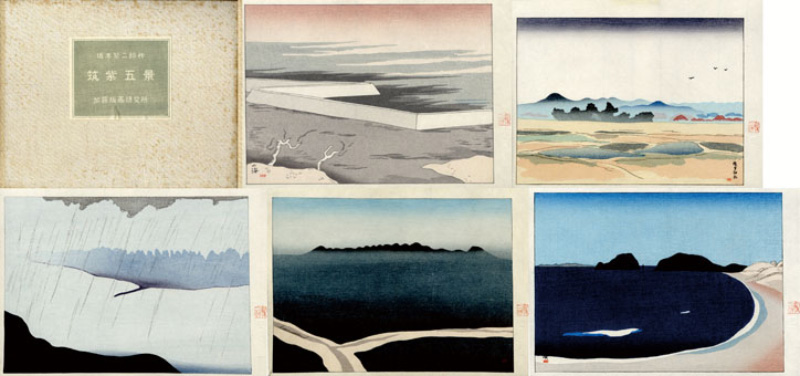About This Print
This print by Sakamoto Hanjirō, picturing the ancient fortifications along Hakata Bay, is from the original set of five prints issued in 1918 by Nakajima Jūtarō titled Tsukishi District which was the sixth set of prints in the ten set series Japan Scenery Prints issued between January 1917 and April 1920. The titles of the prints in Sakamoto's sixth set are: Sea of Fire, Mt. Mino [also seen translated as Mt. Mizunawa], Enoki Temple Shrine, Kami Harbor (Tsukushi Harbor) and Chikugo River.1
This set of five prints by Sakamoto was reissued in 1970 by Katō Junji as part of the portfolio Five Views of Tsukushi. For a comparison between the 1918 and 1970 releases of Sea of Fire, both of which are in this Collection, see the images below. Both the original and newer portfolios are also pictured below.
1 Guide to Modern Japanese Woodblock Prints: 1900-1975, Helen Merritt, University of Hawaii Press, 1992, p. 264.
Source: Modern Japanese Woodblock Prints - The Early Years, Helen Merritt, University of Hawaii Press, 1998, p. 276.
"Sakamoto Hanjirō's, Sea of Fire, 1918, from Set Number Six on the Tsukishi district is simple and elegant. It represents the remains of the stone walls along Hakata Bay which were erected after the first attempted Mongol invasion in 1274. When the Mongols attacked a second time in 1281 they were unable to penetrate the wall and were ultimately defeated by a devastating typhoon which set fire to their ships. Sea of Fire refers to the raging fires in the bay."
Visual Comparison Between the 1918 Release and the 1970 Release
Bottom: the 1970 release from recut blocks
About the Series "Japan Scenery Prints"
Source: Modern Japanese Prints 1912-1989, Lawrence Smith, British Museum Press, 1994, p. 42.
"Tsukushi is the ancient name of the area north-west of Kyushu [in the area of Chikuzen and Chikugo provinces] where Sakamoto was born. Sakamoto was rarely involved with sheet-prints, but like his colleagues on this series he had worked as a cartoonist and illustrator and had been a collaborator on the magazine Hōsun hence he was well used to graphic techniques. Indeed, his set [Tsukushi district] is the most strikingly designed in the series, combining impressionist, abstract and Expressionistic elements into a characteristically forceful blend."
Source: Modern Japanese Woodblock Prints - The Early Years, Helen Merritt, University of Hawaii Press, 1998, p. 274-276.
"The series consisted of ten sets of prints. Each set was composed of five small landscapes and a cover print giving the name of the series, the name and number of the set, and the name of the artist. In addition, each set was accompanied by a table of contents and colophon sheet in standard type. Specific publication dates ranging from January 1917 through April 1920 indicate that each set was issued separately. Since Ishii Hakutei (1882-1958) designed a total of three sets while the other artists did one or two each, it seems likely that Hakutei was the spearhead for the project. The artists asked Igami Bonkutsu to carve the blocks and Nakajima Jūtarō to publish the series.
The Nihon fūkei hanga [Japan Scenery Prints] series was another experiment ... in creating modern prints through the cooperation of carvers and printers. As they had done in the production of [the magazine] Hōsun, the artists put aside the self-carving/self-printing slogan. The main point, they reasoned, was that they were designing for woodblocks and supervising the carving and printing themselves.
Since there is no indication of the edition size, the artists may have intended to follow the usual Japanese publishers' practice of making as many as they could sell. The price is listed on each colophon sheet as one yen fifty-six sen for one set. A notation of postage or shipping cost was pasted onto some of the colophons suggesting that sets were distributed by mail and indicating that Nakajima Jūtarō had not anticipated the problem of postage and had to improvise a means to tell his customers of the extra charge. Hiratsuka Un'ichi (1895-1997), who helped with the carving of some of the late sets while he was studying with Igami Bonkotsu, recalled seeing advertisements for the series in small magazines.
Although the series was neither carved nor printed by the artists, it marked a significant step toward creative independence by shifting the initiative from the hanmoto [publisher] to the artists."
The Six Artist's Involved
| Artist | Set # | Set Title | Date Issued |
| Ishii Hakutei (1882-1958) | 1 | 北陸之部 Hokuriku District | Jan. 8, 1917 |
| Morita Tsunetomo (1881-1933 | 2 | 会津之部 Aizu District | Feb. 11, 1917 |
| Hirafuku Hyakusui (1877-1933) | 3 | 東北之部 Tohoku District | Aug. 20, 1917 |
| Ishii Hakutei (1882-1958) | 4 | 下総之部 Shimōsa Distict | Oct. 1917 |
| Morita Tsunetomo (1881-1933) | 5 | 天草之部 Amakusa District | Dec. 25, 1917 |
| Sakamoto Hanjirō (1882-1969) | 6 | 筑紫之部 Tsukushi District | May 18, 1918 |
| Kosugi Misei (1881-1964) | 7 | 琉球之部 Ryūkyū District | Nov. 13, 1918 |
| Ishii Hakutei (1882-1958) | 8 | 朝鮮之部 Chōsen (Korea) | Dec. 16, 1918 |
| Ishii Tsuruzō (1887-1973)* | 9 | 東京近郊之部 Tokyo Suburbs | Dec. 16, 1919 |
| Ishii Tsuruzō (1887-1973) | 10 | 日本アルプス之部 Japan Alps | Apr. 15, 1920 |
Original 1918 Colophon and Table of Contents for Set 6: Tsukushi District
colophon
click on image to enlarge
Source: National Diet Library Digital Collections
http://dl.ndl.go.jp/info:ndljp/pid/967524table of contents
click on image to enlargeSource: National Diet Library Digital Collections
List of Print Titles and Subtitles from Table of Contents for Set 6: Tsukushi District
| Title | Subtitle | |
 | 榎寺神社 えのきでらじんじゃ Enokidera jinja Enoki Temple Shrine | 都府樓方面より望む とふろうほうめんよりのぞむ Tofurō hōmen yori nozomu |
 | 神の湊 かみのみなと Kami no minatoKami Harbor | 玄海灘を遠望 げんかいなだをえんぼう |
 | 水縄山 みのうさん Minō sanMt. Minō | 小森野より望む こもりのよりのぞむ Komorino yori nozomu |
 | 筑後川 ちくごがわ Chikugo gawaChikugo River | 久留米附近 くるめふきん |
 | 火の海 ひのうみ Hi no umiSea of Fire | 沖の端より望む おきのはたよりのぞむ |
Photographs of the 1918 and 1970 Portfolios
| 筑紫之部 Tsukushi District Set Number Six from the series Japan Scenery Prints, 1918 As originally issued by Nakajima Jūtarō | 筑紫五景 Five Scens of Tsukushi As published in 1970 by Katō Junji (aka Kata Junzō) of Nihon Hanga Kenkyūsho (Kenkyūjo) (Katō Print Institute) |
Print Details
| IHL Catalog | #862 |
| Title |  Title as given in table of contents for 1918 first edition: 火の海 ひのうみ [Hi no umi - Sea of Fire] Subtitle as given in table of contents for 1918 first edition: 沖の端より望む おきのはたよりのぞむ |
| Series | Japan Scenery Prints, Set 6: Tsukushi District (日本風景版画 第六集 筑紫之部 Nihon fūkei hanga, dai-roku shū Tsukushi no bu) Note: Overall series title is also seen translated as Landscape Prints of Japan. |
| Artist | Sakamoto Hanjirō (1882-1969) |
| Signature | unsigned |
| Seal |  |
| Publication Date | May 18, 1918 |
| Edition | first |
| Publisher | Nakajima Jūtarō 中島 重太郎 of the Japan Scenery Prints Association 日本風景版画会 [Marks: pub. ref. 368] |
| Carver | Igami Bonkotsu 伊上凡骨 (1877-1933) |
| Impression | excellent |
| Colors | excellent |
| Condition | good - minor toning and fading; mounting remnants along top edge verso |
| Genre | sosaku hanga (creative print); moku hanga |
| Miscellaneous | |
| Format | chuban |
| H x W Paper | 7 x 9 3/4 in. (17.8 x 24.8 cm) |
| H x W Image | 6 5/8 x 9 3/8 in. (16.8 x 23.8 cm) |
| Collections This Print | Carnegie Museum of Art 89.28.116.3 |
| Reference Literature | Guide to Modern Japanese Woodblock Prints: 1900-1975, Helen Merritt, University of Hawaii Press, 1992, p. 264-265; Modern Japanese Woodblock Prints - The Early Years, Helen Merritt, University of Hawaii Press, 1998, p. 275; Modern Japanese Prints: The Twentieth Century, Amanda T. Zehnder, Carnegie Museum of Art, 2009, p. 155; Images of a Changing World: Japanese Prints of the Twentieth Century, Donald Jenkins, Portland Art Museum, 1983, p. 68. |


